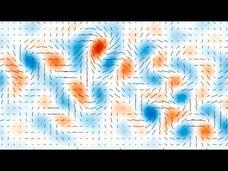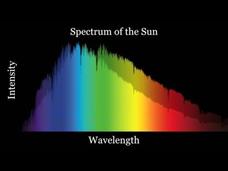SciShow
The Smallest Star in the Universe
They may be small, but probably still mighty! The characteristics of what astronomers have defined as stars have a minimum size requirement. The tiniest stars pack a lot into a small package—and still have all the properties of their...
SciShow
The Star That Trolled Astronomers
Is it a bird, or a plane, or a blinking star? Scientists discovered in 1967 what they later determined to be a pulsing star. An episode of a larger solar system playlist discusses the chemistry behind the existence of this type of star.
SciShow
There's Going to Be a New Star in the Sky
There's something to look forward to in 2021 or 2022! Although the actual event occurred almost 2,000 years ago, the appearance of a new star will become evident from Earth in a few short years. The video instructor from the solar...
SciShow
3 Stars That Shouldn't Exist
A video lesson attempts to explain the unexplainable. The video instructor focuses on three unique stars that have characteristics that astronomers have difficulty explaining. The installment of a solar system playlist includes a heavy,...
SciShow
Extreme Hypothetical Stars
They should exist ... but do they really? Scientists use what they know to predict what should and should not exist. An installment of a larger solar system series looks at the scientific prediction of different stars that have yet to be...
SciShow
The Mysterious Origins of Our Galaxy's Fastest Stars
Many phenomena in space are yet beyond scientific explanation. An episode of a video series on the solar system discusses two recent topics of interest: Uranus' magnetic field and hypervelocity stars. The presenter explains what we know...
SciShow
Do Any Stars NOT Have Planets?
The universe is littered with planets orbiting their suns. The video instructor outlines different methods scientists use to detect these exoplanets. As an installment of a larger solar system playlist, the video discusses current and...
SciShow
How the First Stars Transformed the Universe
Imagine a universe before the formation of stars. An installment of a solar system playlist takes scholars through time to discover the beginning of stars in the universe. The presenter discusses the elements present at the time and how...
TED-Ed
How Far Can We Go? Limits of Humanity.
Imagine living in a neighborhood where the houses on your street keep moving farther away until your house is the only one in the reachable vicinity. That's what is happening in our universe, except your house is our galaxy, and the...
Physics Girl
Everything You Should Know about Trappist-1 Exoplanets
Have we found the next Earth? Join the host of an interesting physics series as she learns what scientists know about the planets orbiting the star Trappist-1 during an engaging video. Astronomers discuss how they located the system,...
Physics Girl
Strange Unexplained Cosmic Rays
The truth about strange unexplained cosmic rays? They're still unexplained! Share one of our universe's many unsolved mysteries with your class using a video from the Physics Girl playlist. The resource describes what cosmic rays are,...
Veritasium
Gravitational Wave Discovery! Evidence of Cosmic Inflation
Can scientists take a picture of the universe before the planets formed? Using telescopes and new technology, scientists take more detailed photos every few years. Cosmic inflation challenges our understanding of the early universe.
PBS
The Speed of Light is NOT About Light
Just when you thought you had this figured out! Engage young physicists in an interesting look at the nature of a universal constant with a video, part of a PBS playlist on space time and measurement....
Be Smart
Why Is The Universe So Empty? (ft. PHD Comics!)
Explore the structure of the universe! An educational video demonstrates the gravitational consequences of different astronomical structures. The presenter starts with the creation of the universe and explains how energy and forces...
PBS
What’s Wrong with the Big Bang Theory?
A video highlights the contradictions in the Big Bang Theory and then discusses the need for a unifying theory of everything. Space Time presents an enlightening video as part of a larger series on Cosmology.
PBS
Why the Big Bang Definitely Happened
According to Space Time, many different studies prove the Big Bang happened. Part of a larger Cosmology playlist, it discusses the common arguments against and the newest science supporting the theory.
PBS
How Cosmic Inflation Flattened the Universe
What if time didn't begin with the big bang? Big Bang doesn't completely answer questions about the beginning of the universe, but cosmic inflation theory holds up better according to scientists in this video. Cosmic inflation fits so...
PBS
What Happens at the Edge of the Universe?
The cosmic even horizon of the universe is closer to us than the particle horizon. Space Time's Cosmology playlist tackles this and other complex concepts about the universe. The video discusses how the scientists define the edge of the...
PBS
Cosmic Microwave Background Explained
As part of their Cosmology series Space Time presents a video that explains the history of electromagnetic waves and the shifting and expanding wavelengths. It finishes by exploring cosmic microwave background radiation.
PBS
Will the Universe Expand Forever?
Scientists from Newton to Friedmann debated the future of the universe. Many scientists thought the universe might collapse on itself in a big crunch, but new mathematical models finally gave us an official answer. The Space Time video,...
PBS
How Do You Measure the Size of the Universe?
The universe is 90 billion light years in diameter. How do scientists measure something so huge? Space Time explains the process as part of its larger Cosmology playlist. The video addresses the steps to solving the puzzle as well as how...
Kurzgesagt – In a Nutshell
The Beginning of Everything—The Big Bang
How can something come from nothing? The Big Bang Theory has an answer to that question. An installment in the Kurzgesagt playlist outlines the theory of the origin of the universe. It includes an explanation of the evidence that...
Veritasium
Why the Sky ISN'T Blue
The answer is: a method to celebrate a major milestone. A proud video celebrates 500,000 followers and gives an idea of how big that number is. The resource in the Veritasium playlist goes on to answer several questions posed by...
Veritasium
Galaxies From Nothing
Space can never be truly empty because fields occupy the seemingly empty space. Another installment of the Veritasium playlist attempts to explain the science of the creation of the galaxies. By referencing the quantum fluctuations, the...























